Health and Safety Regulations in Caribbean Construction: A Report
VerifiedAdded on 2020/03/16
|12
|3408
|89
Report
AI Summary
This report examines health and safety practices within a Caribbean construction company, focusing on a case study involving a workplace accident. It highlights the importance of adhering to government regulations designed to protect employees. The report details various hazards present in the construction environment, including electrocution, dust exposure, and physical risks. It analyzes how a safety breach could have been avoided through adherence to safety guidelines, proper gate sizing, and the absence of live electrical wires. The report also discusses the legal consequences of non-compliance, including fines and the need for emergency personnel. Ultimately, the report underscores the significance of prioritizing worker well-being and adhering to health and safety protocols to prevent accidents and ensure a safe working environment. This report is contributed by a student to Desklib, a platform providing AI-based study tools.
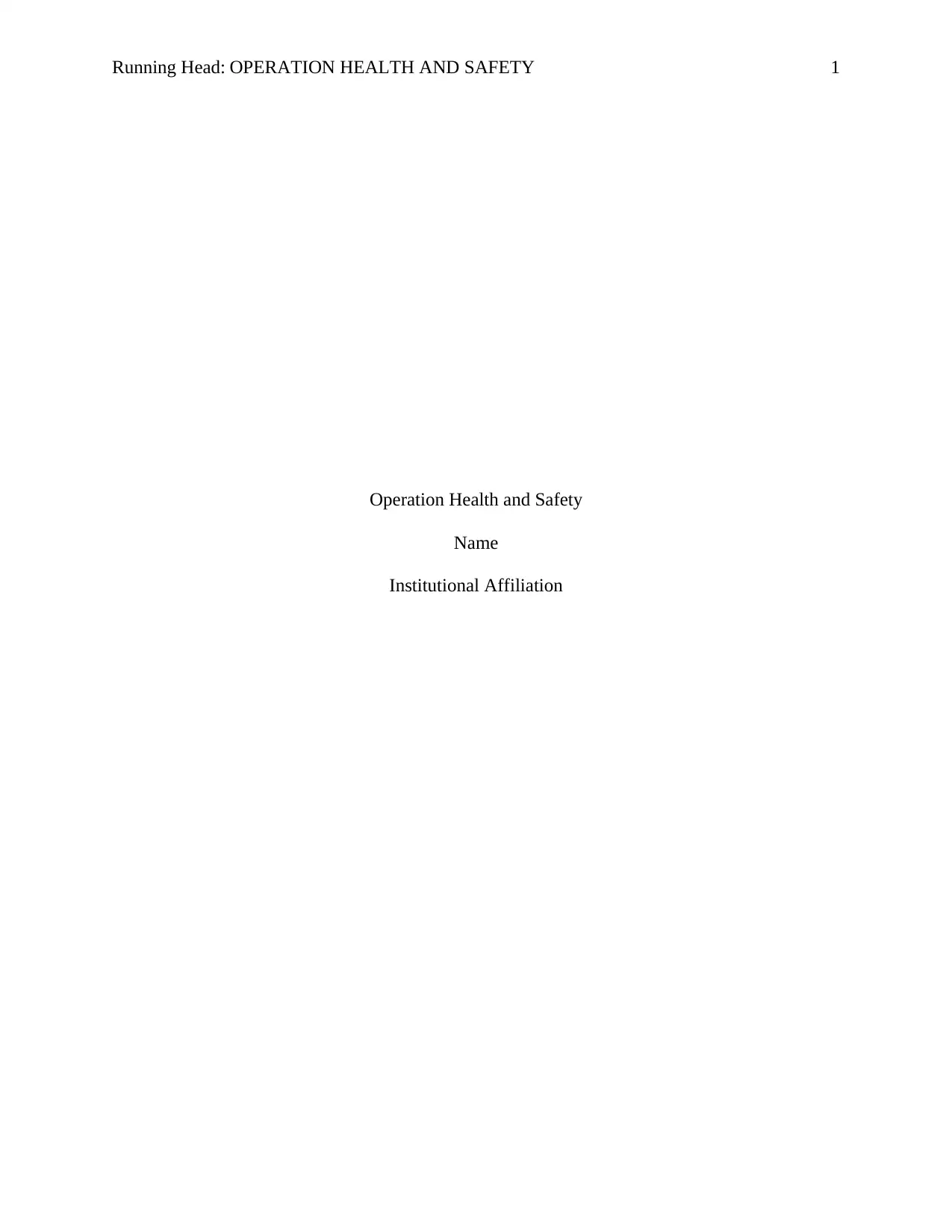
Running Head: OPERATION HEALTH AND SAFETY 1
Operation Health and Safety
Name
Institutional Affiliation
Operation Health and Safety
Name
Institutional Affiliation
Paraphrase This Document
Need a fresh take? Get an instant paraphrase of this document with our AI Paraphraser
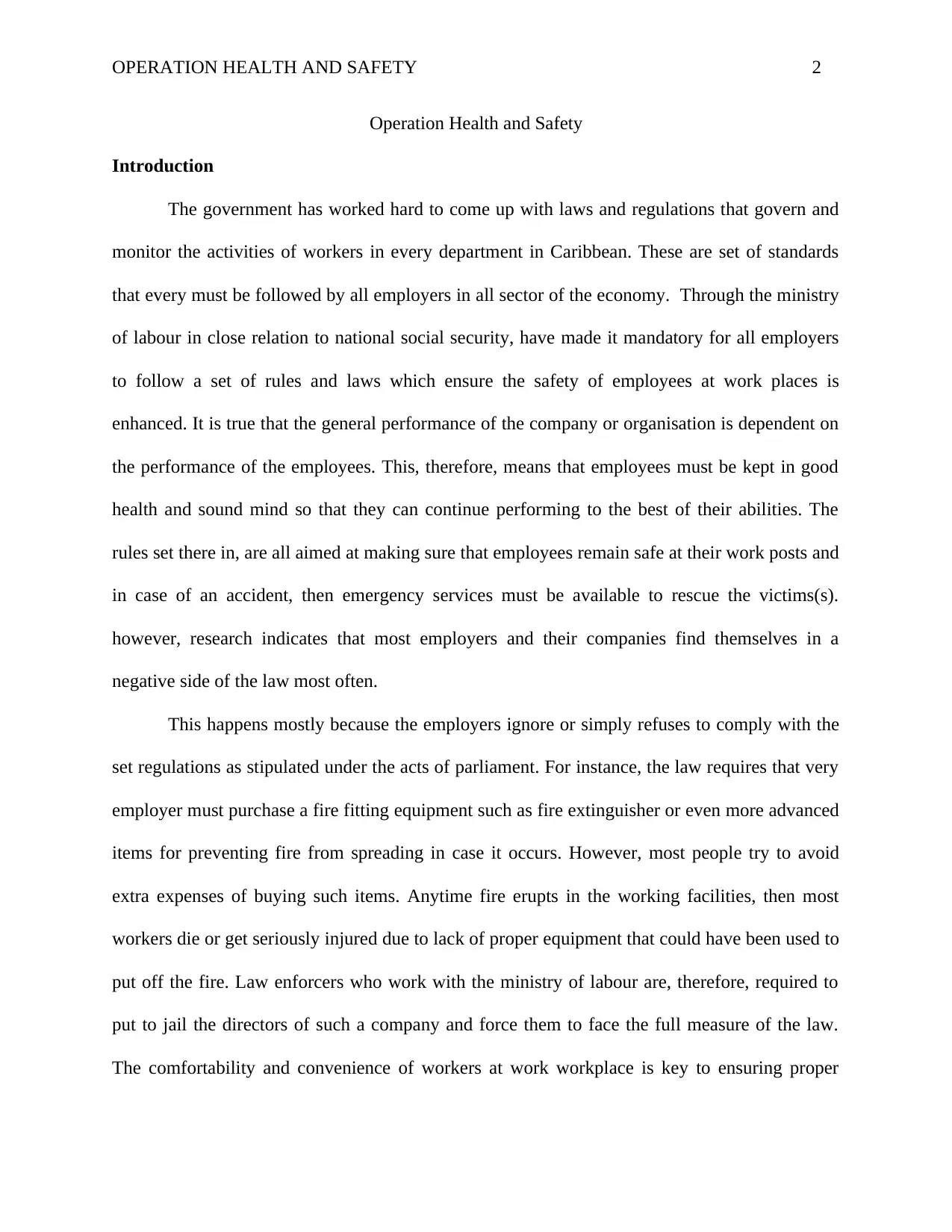
OPERATION HEALTH AND SAFETY 2
Operation Health and Safety
Introduction
The government has worked hard to come up with laws and regulations that govern and
monitor the activities of workers in every department in Caribbean. These are set of standards
that every must be followed by all employers in all sector of the economy. Through the ministry
of labour in close relation to national social security, have made it mandatory for all employers
to follow a set of rules and laws which ensure the safety of employees at work places is
enhanced. It is true that the general performance of the company or organisation is dependent on
the performance of the employees. This, therefore, means that employees must be kept in good
health and sound mind so that they can continue performing to the best of their abilities. The
rules set there in, are all aimed at making sure that employees remain safe at their work posts and
in case of an accident, then emergency services must be available to rescue the victims(s).
however, research indicates that most employers and their companies find themselves in a
negative side of the law most often.
This happens mostly because the employers ignore or simply refuses to comply with the
set regulations as stipulated under the acts of parliament. For instance, the law requires that very
employer must purchase a fire fitting equipment such as fire extinguisher or even more advanced
items for preventing fire from spreading in case it occurs. However, most people try to avoid
extra expenses of buying such items. Anytime fire erupts in the working facilities, then most
workers die or get seriously injured due to lack of proper equipment that could have been used to
put off the fire. Law enforcers who work with the ministry of labour are, therefore, required to
put to jail the directors of such a company and force them to face the full measure of the law.
The comfortability and convenience of workers at work workplace is key to ensuring proper
Operation Health and Safety
Introduction
The government has worked hard to come up with laws and regulations that govern and
monitor the activities of workers in every department in Caribbean. These are set of standards
that every must be followed by all employers in all sector of the economy. Through the ministry
of labour in close relation to national social security, have made it mandatory for all employers
to follow a set of rules and laws which ensure the safety of employees at work places is
enhanced. It is true that the general performance of the company or organisation is dependent on
the performance of the employees. This, therefore, means that employees must be kept in good
health and sound mind so that they can continue performing to the best of their abilities. The
rules set there in, are all aimed at making sure that employees remain safe at their work posts and
in case of an accident, then emergency services must be available to rescue the victims(s).
however, research indicates that most employers and their companies find themselves in a
negative side of the law most often.
This happens mostly because the employers ignore or simply refuses to comply with the
set regulations as stipulated under the acts of parliament. For instance, the law requires that very
employer must purchase a fire fitting equipment such as fire extinguisher or even more advanced
items for preventing fire from spreading in case it occurs. However, most people try to avoid
extra expenses of buying such items. Anytime fire erupts in the working facilities, then most
workers die or get seriously injured due to lack of proper equipment that could have been used to
put off the fire. Law enforcers who work with the ministry of labour are, therefore, required to
put to jail the directors of such a company and force them to face the full measure of the law.
The comfortability and convenience of workers at work workplace is key to ensuring proper
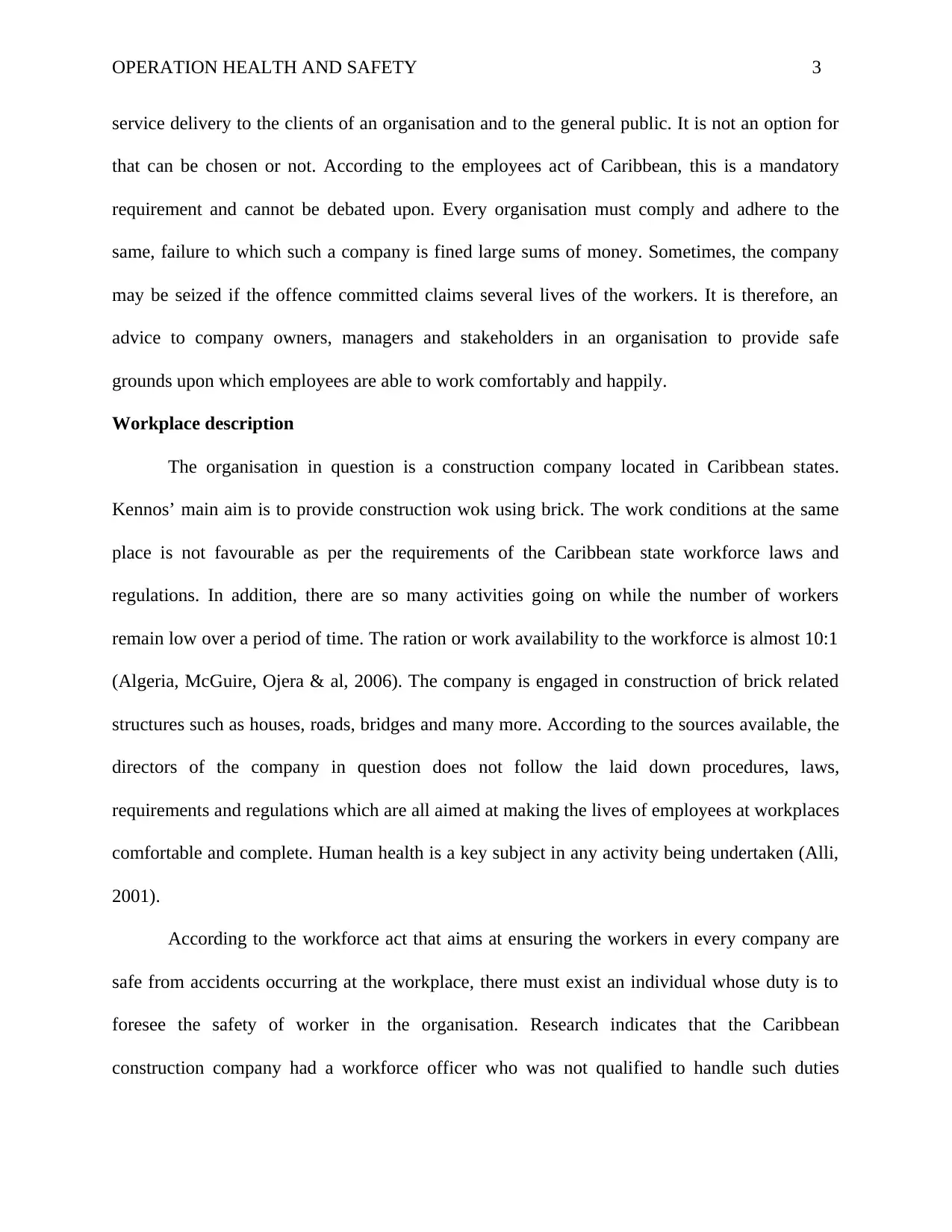
OPERATION HEALTH AND SAFETY 3
service delivery to the clients of an organisation and to the general public. It is not an option for
that can be chosen or not. According to the employees act of Caribbean, this is a mandatory
requirement and cannot be debated upon. Every organisation must comply and adhere to the
same, failure to which such a company is fined large sums of money. Sometimes, the company
may be seized if the offence committed claims several lives of the workers. It is therefore, an
advice to company owners, managers and stakeholders in an organisation to provide safe
grounds upon which employees are able to work comfortably and happily.
Workplace description
The organisation in question is a construction company located in Caribbean states.
Kennos’ main aim is to provide construction wok using brick. The work conditions at the same
place is not favourable as per the requirements of the Caribbean state workforce laws and
regulations. In addition, there are so many activities going on while the number of workers
remain low over a period of time. The ration or work availability to the workforce is almost 10:1
(Algeria, McGuire, Ojera & al, 2006). The company is engaged in construction of brick related
structures such as houses, roads, bridges and many more. According to the sources available, the
directors of the company in question does not follow the laid down procedures, laws,
requirements and regulations which are all aimed at making the lives of employees at workplaces
comfortable and complete. Human health is a key subject in any activity being undertaken (Alli,
2001).
According to the workforce act that aims at ensuring the workers in every company are
safe from accidents occurring at the workplace, there must exist an individual whose duty is to
foresee the safety of worker in the organisation. Research indicates that the Caribbean
construction company had a workforce officer who was not qualified to handle such duties
service delivery to the clients of an organisation and to the general public. It is not an option for
that can be chosen or not. According to the employees act of Caribbean, this is a mandatory
requirement and cannot be debated upon. Every organisation must comply and adhere to the
same, failure to which such a company is fined large sums of money. Sometimes, the company
may be seized if the offence committed claims several lives of the workers. It is therefore, an
advice to company owners, managers and stakeholders in an organisation to provide safe
grounds upon which employees are able to work comfortably and happily.
Workplace description
The organisation in question is a construction company located in Caribbean states.
Kennos’ main aim is to provide construction wok using brick. The work conditions at the same
place is not favourable as per the requirements of the Caribbean state workforce laws and
regulations. In addition, there are so many activities going on while the number of workers
remain low over a period of time. The ration or work availability to the workforce is almost 10:1
(Algeria, McGuire, Ojera & al, 2006). The company is engaged in construction of brick related
structures such as houses, roads, bridges and many more. According to the sources available, the
directors of the company in question does not follow the laid down procedures, laws,
requirements and regulations which are all aimed at making the lives of employees at workplaces
comfortable and complete. Human health is a key subject in any activity being undertaken (Alli,
2001).
According to the workforce act that aims at ensuring the workers in every company are
safe from accidents occurring at the workplace, there must exist an individual whose duty is to
foresee the safety of worker in the organisation. Research indicates that the Caribbean
construction company had a workforce officer who was not qualified to handle such duties
⊘ This is a preview!⊘
Do you want full access?
Subscribe today to unlock all pages.

Trusted by 1+ million students worldwide
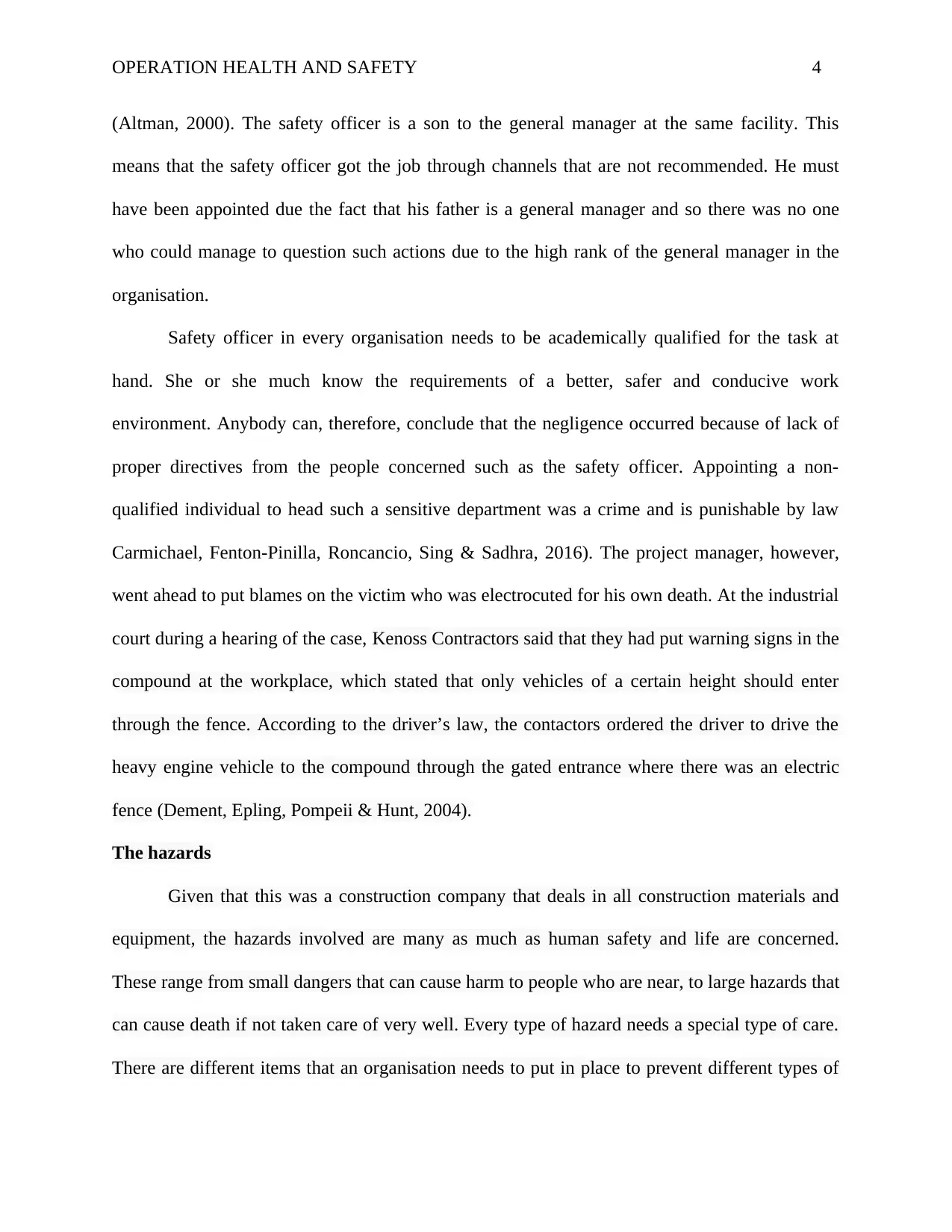
OPERATION HEALTH AND SAFETY 4
(Altman, 2000). The safety officer is a son to the general manager at the same facility. This
means that the safety officer got the job through channels that are not recommended. He must
have been appointed due the fact that his father is a general manager and so there was no one
who could manage to question such actions due to the high rank of the general manager in the
organisation.
Safety officer in every organisation needs to be academically qualified for the task at
hand. She or she much know the requirements of a better, safer and conducive work
environment. Anybody can, therefore, conclude that the negligence occurred because of lack of
proper directives from the people concerned such as the safety officer. Appointing a non-
qualified individual to head such a sensitive department was a crime and is punishable by law
Carmichael, Fenton-Pinilla, Roncancio, Sing & Sadhra, 2016). The project manager, however,
went ahead to put blames on the victim who was electrocuted for his own death. At the industrial
court during a hearing of the case, Kenoss Contractors said that they had put warning signs in the
compound at the workplace, which stated that only vehicles of a certain height should enter
through the fence. According to the driver’s law, the contactors ordered the driver to drive the
heavy engine vehicle to the compound through the gated entrance where there was an electric
fence (Dement, Epling, Pompeii & Hunt, 2004).
The hazards
Given that this was a construction company that deals in all construction materials and
equipment, the hazards involved are many as much as human safety and life are concerned.
These range from small dangers that can cause harm to people who are near, to large hazards that
can cause death if not taken care of very well. Every type of hazard needs a special type of care.
There are different items that an organisation needs to put in place to prevent different types of
(Altman, 2000). The safety officer is a son to the general manager at the same facility. This
means that the safety officer got the job through channels that are not recommended. He must
have been appointed due the fact that his father is a general manager and so there was no one
who could manage to question such actions due to the high rank of the general manager in the
organisation.
Safety officer in every organisation needs to be academically qualified for the task at
hand. She or she much know the requirements of a better, safer and conducive work
environment. Anybody can, therefore, conclude that the negligence occurred because of lack of
proper directives from the people concerned such as the safety officer. Appointing a non-
qualified individual to head such a sensitive department was a crime and is punishable by law
Carmichael, Fenton-Pinilla, Roncancio, Sing & Sadhra, 2016). The project manager, however,
went ahead to put blames on the victim who was electrocuted for his own death. At the industrial
court during a hearing of the case, Kenoss Contractors said that they had put warning signs in the
compound at the workplace, which stated that only vehicles of a certain height should enter
through the fence. According to the driver’s law, the contactors ordered the driver to drive the
heavy engine vehicle to the compound through the gated entrance where there was an electric
fence (Dement, Epling, Pompeii & Hunt, 2004).
The hazards
Given that this was a construction company that deals in all construction materials and
equipment, the hazards involved are many as much as human safety and life are concerned.
These range from small dangers that can cause harm to people who are near, to large hazards that
can cause death if not taken care of very well. Every type of hazard needs a special type of care.
There are different items that an organisation needs to put in place to prevent different types of
Paraphrase This Document
Need a fresh take? Get an instant paraphrase of this document with our AI Paraphraser
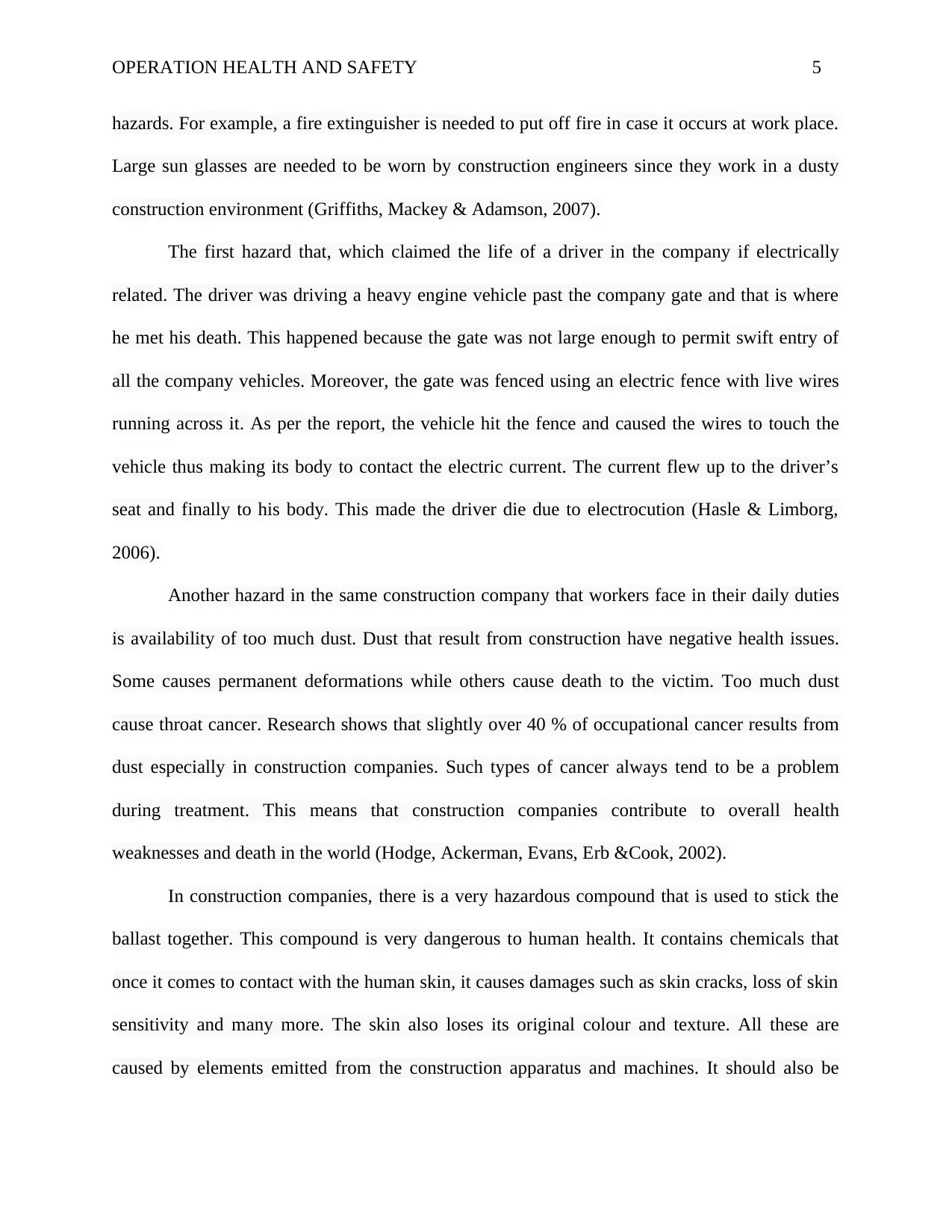
OPERATION HEALTH AND SAFETY 5
hazards. For example, a fire extinguisher is needed to put off fire in case it occurs at work place.
Large sun glasses are needed to be worn by construction engineers since they work in a dusty
construction environment (Griffiths, Mackey & Adamson, 2007).
The first hazard that, which claimed the life of a driver in the company if electrically
related. The driver was driving a heavy engine vehicle past the company gate and that is where
he met his death. This happened because the gate was not large enough to permit swift entry of
all the company vehicles. Moreover, the gate was fenced using an electric fence with live wires
running across it. As per the report, the vehicle hit the fence and caused the wires to touch the
vehicle thus making its body to contact the electric current. The current flew up to the driver’s
seat and finally to his body. This made the driver die due to electrocution (Hasle & Limborg,
2006).
Another hazard in the same construction company that workers face in their daily duties
is availability of too much dust. Dust that result from construction have negative health issues.
Some causes permanent deformations while others cause death to the victim. Too much dust
cause throat cancer. Research shows that slightly over 40 % of occupational cancer results from
dust especially in construction companies. Such types of cancer always tend to be a problem
during treatment. This means that construction companies contribute to overall health
weaknesses and death in the world (Hodge, Ackerman, Evans, Erb &Cook, 2002).
In construction companies, there is a very hazardous compound that is used to stick the
ballast together. This compound is very dangerous to human health. It contains chemicals that
once it comes to contact with the human skin, it causes damages such as skin cracks, loss of skin
sensitivity and many more. The skin also loses its original colour and texture. All these are
caused by elements emitted from the construction apparatus and machines. It should also be
hazards. For example, a fire extinguisher is needed to put off fire in case it occurs at work place.
Large sun glasses are needed to be worn by construction engineers since they work in a dusty
construction environment (Griffiths, Mackey & Adamson, 2007).
The first hazard that, which claimed the life of a driver in the company if electrically
related. The driver was driving a heavy engine vehicle past the company gate and that is where
he met his death. This happened because the gate was not large enough to permit swift entry of
all the company vehicles. Moreover, the gate was fenced using an electric fence with live wires
running across it. As per the report, the vehicle hit the fence and caused the wires to touch the
vehicle thus making its body to contact the electric current. The current flew up to the driver’s
seat and finally to his body. This made the driver die due to electrocution (Hasle & Limborg,
2006).
Another hazard in the same construction company that workers face in their daily duties
is availability of too much dust. Dust that result from construction have negative health issues.
Some causes permanent deformations while others cause death to the victim. Too much dust
cause throat cancer. Research shows that slightly over 40 % of occupational cancer results from
dust especially in construction companies. Such types of cancer always tend to be a problem
during treatment. This means that construction companies contribute to overall health
weaknesses and death in the world (Hodge, Ackerman, Evans, Erb &Cook, 2002).
In construction companies, there is a very hazardous compound that is used to stick the
ballast together. This compound is very dangerous to human health. It contains chemicals that
once it comes to contact with the human skin, it causes damages such as skin cracks, loss of skin
sensitivity and many more. The skin also loses its original colour and texture. All these are
caused by elements emitted from the construction apparatus and machines. It should also be
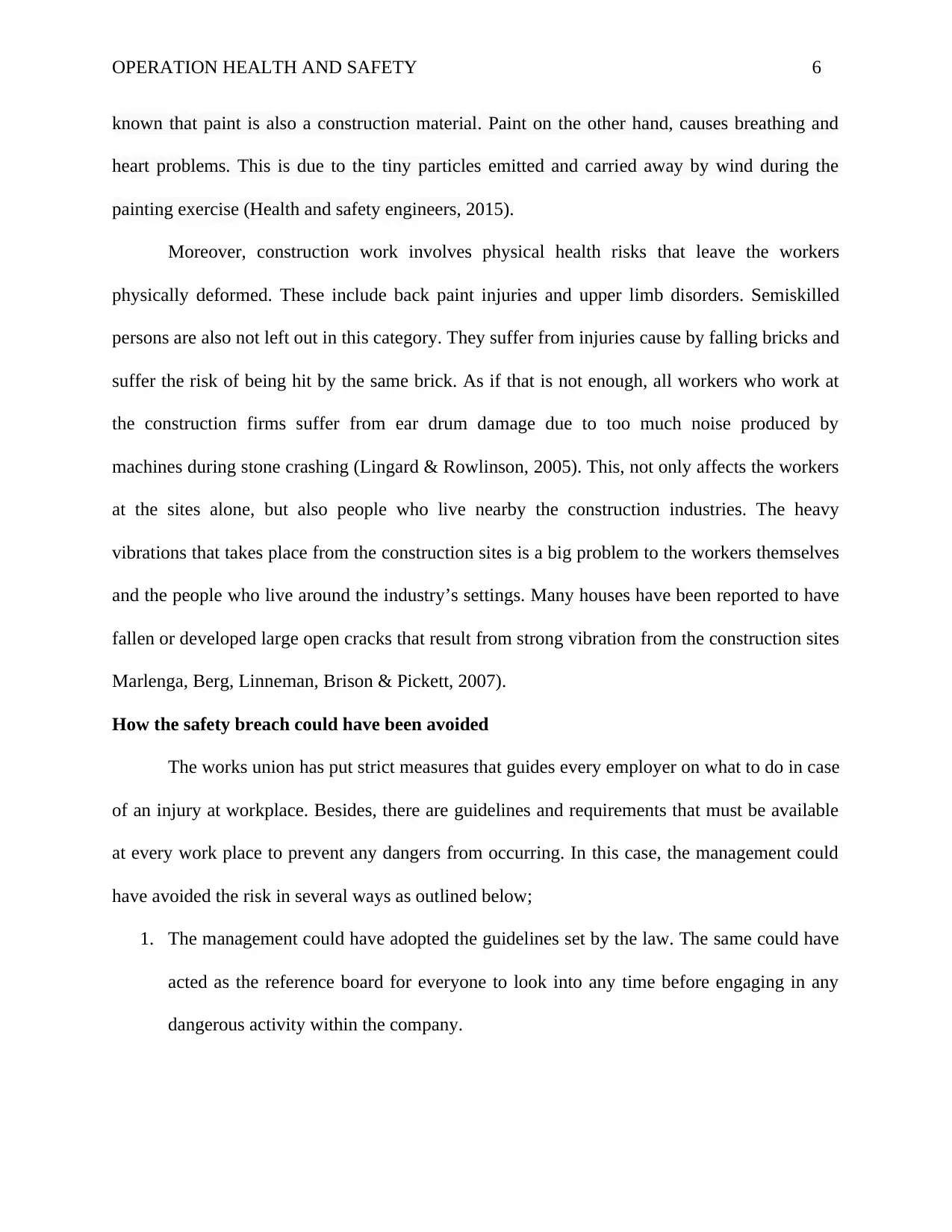
OPERATION HEALTH AND SAFETY 6
known that paint is also a construction material. Paint on the other hand, causes breathing and
heart problems. This is due to the tiny particles emitted and carried away by wind during the
painting exercise (Health and safety engineers, 2015).
Moreover, construction work involves physical health risks that leave the workers
physically deformed. These include back paint injuries and upper limb disorders. Semiskilled
persons are also not left out in this category. They suffer from injuries cause by falling bricks and
suffer the risk of being hit by the same brick. As if that is not enough, all workers who work at
the construction firms suffer from ear drum damage due to too much noise produced by
machines during stone crashing (Lingard & Rowlinson, 2005). This, not only affects the workers
at the sites alone, but also people who live nearby the construction industries. The heavy
vibrations that takes place from the construction sites is a big problem to the workers themselves
and the people who live around the industry’s settings. Many houses have been reported to have
fallen or developed large open cracks that result from strong vibration from the construction sites
Marlenga, Berg, Linneman, Brison & Pickett, 2007).
How the safety breach could have been avoided
The works union has put strict measures that guides every employer on what to do in case
of an injury at workplace. Besides, there are guidelines and requirements that must be available
at every work place to prevent any dangers from occurring. In this case, the management could
have avoided the risk in several ways as outlined below;
1. The management could have adopted the guidelines set by the law. The same could have
acted as the reference board for everyone to look into any time before engaging in any
dangerous activity within the company.
known that paint is also a construction material. Paint on the other hand, causes breathing and
heart problems. This is due to the tiny particles emitted and carried away by wind during the
painting exercise (Health and safety engineers, 2015).
Moreover, construction work involves physical health risks that leave the workers
physically deformed. These include back paint injuries and upper limb disorders. Semiskilled
persons are also not left out in this category. They suffer from injuries cause by falling bricks and
suffer the risk of being hit by the same brick. As if that is not enough, all workers who work at
the construction firms suffer from ear drum damage due to too much noise produced by
machines during stone crashing (Lingard & Rowlinson, 2005). This, not only affects the workers
at the sites alone, but also people who live nearby the construction industries. The heavy
vibrations that takes place from the construction sites is a big problem to the workers themselves
and the people who live around the industry’s settings. Many houses have been reported to have
fallen or developed large open cracks that result from strong vibration from the construction sites
Marlenga, Berg, Linneman, Brison & Pickett, 2007).
How the safety breach could have been avoided
The works union has put strict measures that guides every employer on what to do in case
of an injury at workplace. Besides, there are guidelines and requirements that must be available
at every work place to prevent any dangers from occurring. In this case, the management could
have avoided the risk in several ways as outlined below;
1. The management could have adopted the guidelines set by the law. The same could have
acted as the reference board for everyone to look into any time before engaging in any
dangerous activity within the company.
⊘ This is a preview!⊘
Do you want full access?
Subscribe today to unlock all pages.

Trusted by 1+ million students worldwide
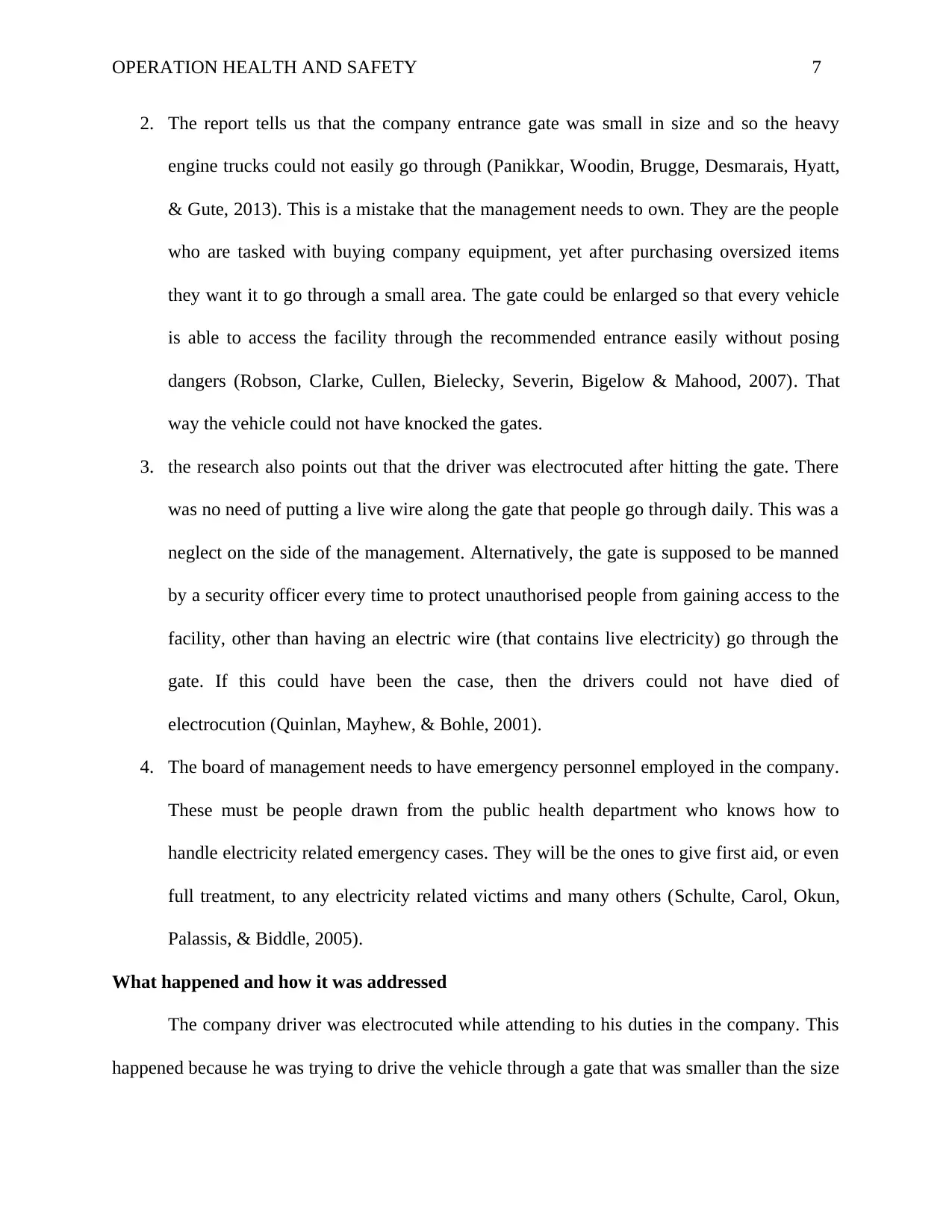
OPERATION HEALTH AND SAFETY 7
2. The report tells us that the company entrance gate was small in size and so the heavy
engine trucks could not easily go through (Panikkar, Woodin, Brugge, Desmarais, Hyatt,
& Gute, 2013). This is a mistake that the management needs to own. They are the people
who are tasked with buying company equipment, yet after purchasing oversized items
they want it to go through a small area. The gate could be enlarged so that every vehicle
is able to access the facility through the recommended entrance easily without posing
dangers (Robson, Clarke, Cullen, Bielecky, Severin, Bigelow & Mahood, 2007). That
way the vehicle could not have knocked the gates.
3. the research also points out that the driver was electrocuted after hitting the gate. There
was no need of putting a live wire along the gate that people go through daily. This was a
neglect on the side of the management. Alternatively, the gate is supposed to be manned
by a security officer every time to protect unauthorised people from gaining access to the
facility, other than having an electric wire (that contains live electricity) go through the
gate. If this could have been the case, then the drivers could not have died of
electrocution (Quinlan, Mayhew, & Bohle, 2001).
4. The board of management needs to have emergency personnel employed in the company.
These must be people drawn from the public health department who knows how to
handle electricity related emergency cases. They will be the ones to give first aid, or even
full treatment, to any electricity related victims and many others (Schulte, Carol, Okun,
Palassis, & Biddle, 2005).
What happened and how it was addressed
The company driver was electrocuted while attending to his duties in the company. This
happened because he was trying to drive the vehicle through a gate that was smaller than the size
2. The report tells us that the company entrance gate was small in size and so the heavy
engine trucks could not easily go through (Panikkar, Woodin, Brugge, Desmarais, Hyatt,
& Gute, 2013). This is a mistake that the management needs to own. They are the people
who are tasked with buying company equipment, yet after purchasing oversized items
they want it to go through a small area. The gate could be enlarged so that every vehicle
is able to access the facility through the recommended entrance easily without posing
dangers (Robson, Clarke, Cullen, Bielecky, Severin, Bigelow & Mahood, 2007). That
way the vehicle could not have knocked the gates.
3. the research also points out that the driver was electrocuted after hitting the gate. There
was no need of putting a live wire along the gate that people go through daily. This was a
neglect on the side of the management. Alternatively, the gate is supposed to be manned
by a security officer every time to protect unauthorised people from gaining access to the
facility, other than having an electric wire (that contains live electricity) go through the
gate. If this could have been the case, then the drivers could not have died of
electrocution (Quinlan, Mayhew, & Bohle, 2001).
4. The board of management needs to have emergency personnel employed in the company.
These must be people drawn from the public health department who knows how to
handle electricity related emergency cases. They will be the ones to give first aid, or even
full treatment, to any electricity related victims and many others (Schulte, Carol, Okun,
Palassis, & Biddle, 2005).
What happened and how it was addressed
The company driver was electrocuted while attending to his duties in the company. This
happened because he was trying to drive the vehicle through a gate that was smaller than the size
Paraphrase This Document
Need a fresh take? Get an instant paraphrase of this document with our AI Paraphraser
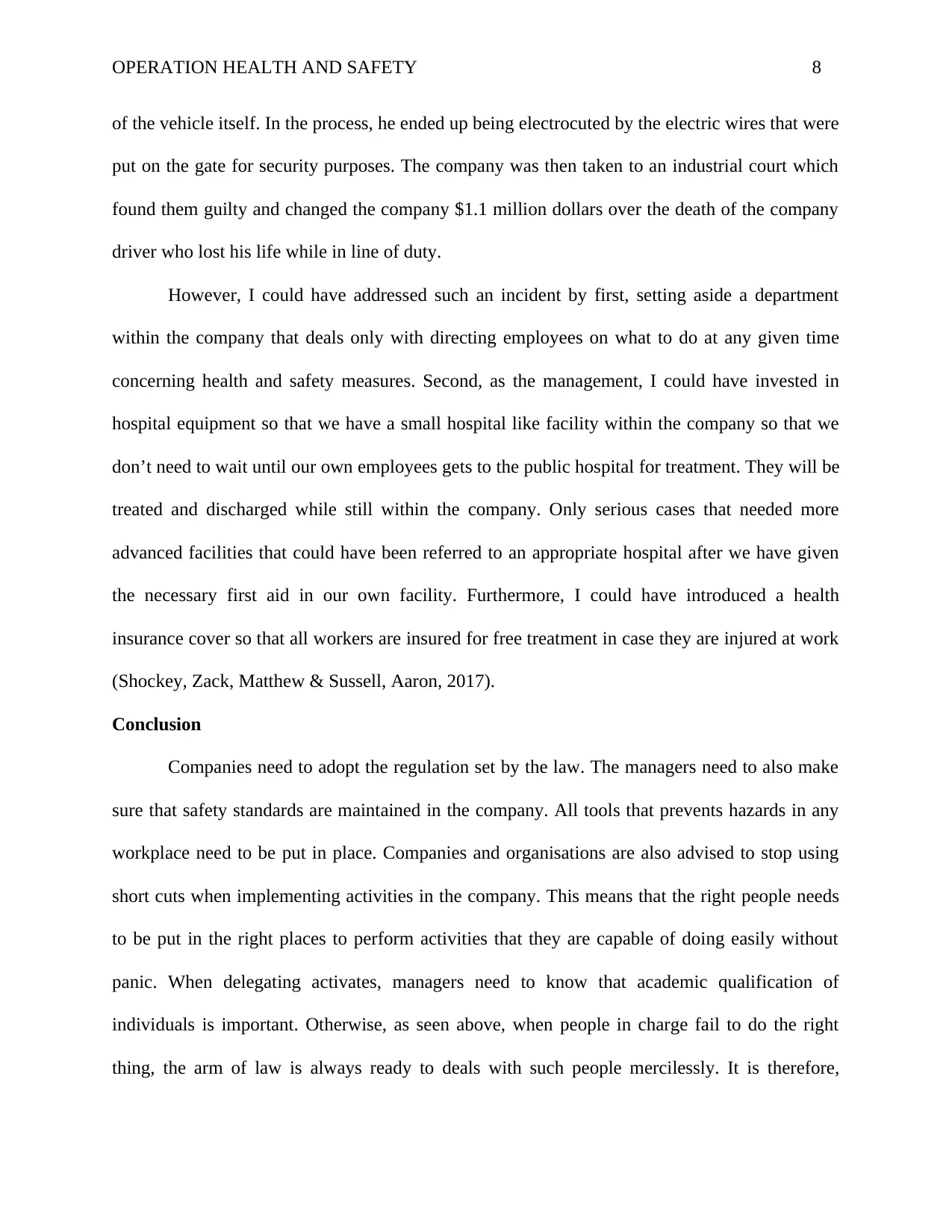
OPERATION HEALTH AND SAFETY 8
of the vehicle itself. In the process, he ended up being electrocuted by the electric wires that were
put on the gate for security purposes. The company was then taken to an industrial court which
found them guilty and changed the company $1.1 million dollars over the death of the company
driver who lost his life while in line of duty.
However, I could have addressed such an incident by first, setting aside a department
within the company that deals only with directing employees on what to do at any given time
concerning health and safety measures. Second, as the management, I could have invested in
hospital equipment so that we have a small hospital like facility within the company so that we
don’t need to wait until our own employees gets to the public hospital for treatment. They will be
treated and discharged while still within the company. Only serious cases that needed more
advanced facilities that could have been referred to an appropriate hospital after we have given
the necessary first aid in our own facility. Furthermore, I could have introduced a health
insurance cover so that all workers are insured for free treatment in case they are injured at work
(Shockey, Zack, Matthew & Sussell, Aaron, 2017).
Conclusion
Companies need to adopt the regulation set by the law. The managers need to also make
sure that safety standards are maintained in the company. All tools that prevents hazards in any
workplace need to be put in place. Companies and organisations are also advised to stop using
short cuts when implementing activities in the company. This means that the right people needs
to be put in the right places to perform activities that they are capable of doing easily without
panic. When delegating activates, managers need to know that academic qualification of
individuals is important. Otherwise, as seen above, when people in charge fail to do the right
thing, the arm of law is always ready to deals with such people mercilessly. It is therefore,
of the vehicle itself. In the process, he ended up being electrocuted by the electric wires that were
put on the gate for security purposes. The company was then taken to an industrial court which
found them guilty and changed the company $1.1 million dollars over the death of the company
driver who lost his life while in line of duty.
However, I could have addressed such an incident by first, setting aside a department
within the company that deals only with directing employees on what to do at any given time
concerning health and safety measures. Second, as the management, I could have invested in
hospital equipment so that we have a small hospital like facility within the company so that we
don’t need to wait until our own employees gets to the public hospital for treatment. They will be
treated and discharged while still within the company. Only serious cases that needed more
advanced facilities that could have been referred to an appropriate hospital after we have given
the necessary first aid in our own facility. Furthermore, I could have introduced a health
insurance cover so that all workers are insured for free treatment in case they are injured at work
(Shockey, Zack, Matthew & Sussell, Aaron, 2017).
Conclusion
Companies need to adopt the regulation set by the law. The managers need to also make
sure that safety standards are maintained in the company. All tools that prevents hazards in any
workplace need to be put in place. Companies and organisations are also advised to stop using
short cuts when implementing activities in the company. This means that the right people needs
to be put in the right places to perform activities that they are capable of doing easily without
panic. When delegating activates, managers need to know that academic qualification of
individuals is important. Otherwise, as seen above, when people in charge fail to do the right
thing, the arm of law is always ready to deals with such people mercilessly. It is therefore,
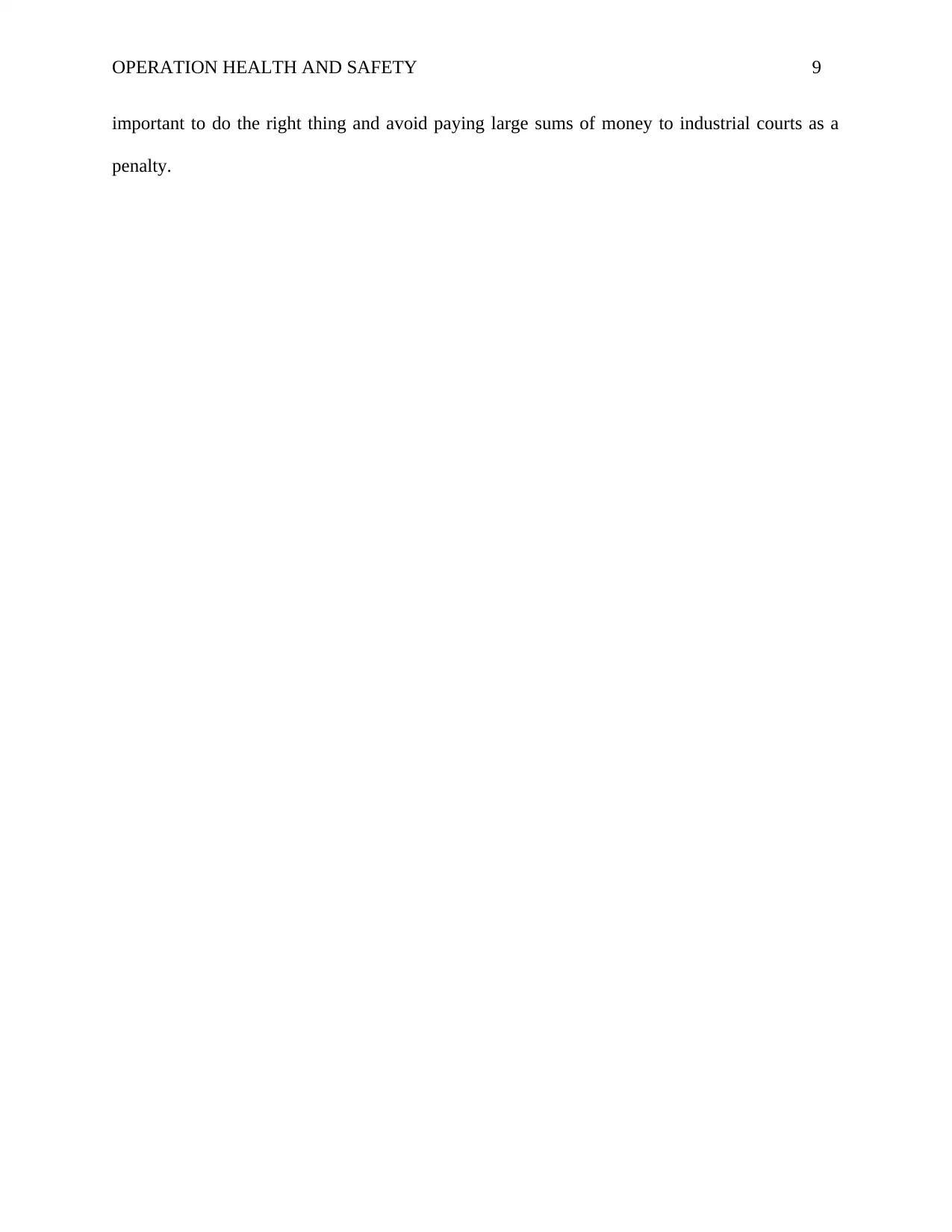
OPERATION HEALTH AND SAFETY 9
important to do the right thing and avoid paying large sums of money to industrial courts as a
penalty.
important to do the right thing and avoid paying large sums of money to industrial courts as a
penalty.
⊘ This is a preview!⊘
Do you want full access?
Subscribe today to unlock all pages.

Trusted by 1+ million students worldwide
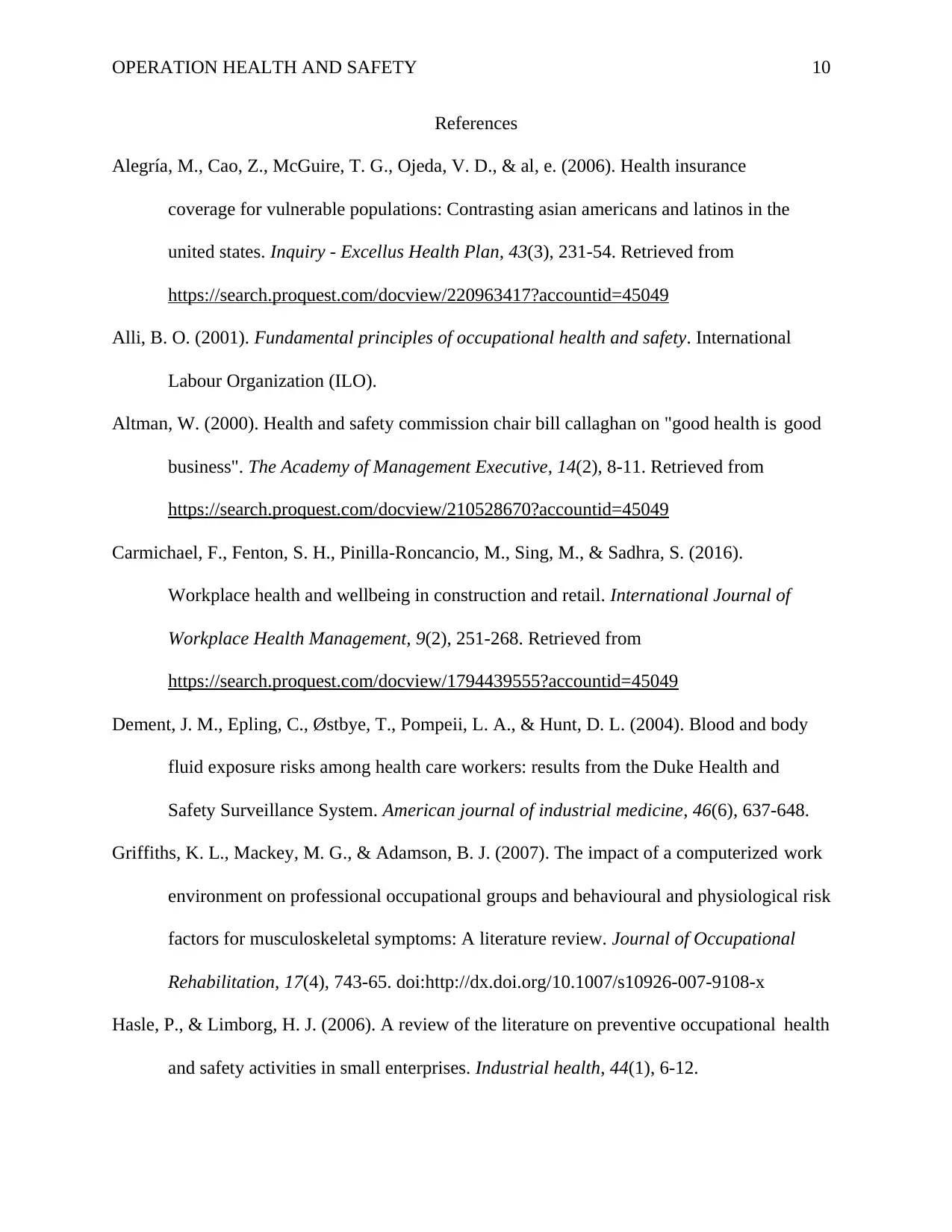
OPERATION HEALTH AND SAFETY 10
References
Alegría, M., Cao, Z., McGuire, T. G., Ojeda, V. D., & al, e. (2006). Health insurance
coverage for vulnerable populations: Contrasting asian americans and latinos in the
united states. Inquiry - Excellus Health Plan, 43(3), 231-54. Retrieved from
https://search.proquest.com/docview/220963417?accountid=45049
Alli, B. O. (2001). Fundamental principles of occupational health and safety. International
Labour Organization (ILO).
Altman, W. (2000). Health and safety commission chair bill callaghan on "good health is good
business". The Academy of Management Executive, 14(2), 8-11. Retrieved from
https://search.proquest.com/docview/210528670?accountid=45049
Carmichael, F., Fenton, S. H., Pinilla-Roncancio, M., Sing, M., & Sadhra, S. (2016).
Workplace health and wellbeing in construction and retail. International Journal of
Workplace Health Management, 9(2), 251-268. Retrieved from
https://search.proquest.com/docview/1794439555?accountid=45049
Dement, J. M., Epling, C., Østbye, T., Pompeii, L. A., & Hunt, D. L. (2004). Blood and body
fluid exposure risks among health care workers: results from the Duke Health and
Safety Surveillance System. American journal of industrial medicine, 46(6), 637-648.
Griffiths, K. L., Mackey, M. G., & Adamson, B. J. (2007). The impact of a computerized work
environment on professional occupational groups and behavioural and physiological risk
factors for musculoskeletal symptoms: A literature review. Journal of Occupational
Rehabilitation, 17(4), 743-65. doi:http://dx.doi.org/10.1007/s10926-007-9108-x
Hasle, P., & Limborg, H. J. (2006). A review of the literature on preventive occupational health
and safety activities in small enterprises. Industrial health, 44(1), 6-12.
References
Alegría, M., Cao, Z., McGuire, T. G., Ojeda, V. D., & al, e. (2006). Health insurance
coverage for vulnerable populations: Contrasting asian americans and latinos in the
united states. Inquiry - Excellus Health Plan, 43(3), 231-54. Retrieved from
https://search.proquest.com/docview/220963417?accountid=45049
Alli, B. O. (2001). Fundamental principles of occupational health and safety. International
Labour Organization (ILO).
Altman, W. (2000). Health and safety commission chair bill callaghan on "good health is good
business". The Academy of Management Executive, 14(2), 8-11. Retrieved from
https://search.proquest.com/docview/210528670?accountid=45049
Carmichael, F., Fenton, S. H., Pinilla-Roncancio, M., Sing, M., & Sadhra, S. (2016).
Workplace health and wellbeing in construction and retail. International Journal of
Workplace Health Management, 9(2), 251-268. Retrieved from
https://search.proquest.com/docview/1794439555?accountid=45049
Dement, J. M., Epling, C., Østbye, T., Pompeii, L. A., & Hunt, D. L. (2004). Blood and body
fluid exposure risks among health care workers: results from the Duke Health and
Safety Surveillance System. American journal of industrial medicine, 46(6), 637-648.
Griffiths, K. L., Mackey, M. G., & Adamson, B. J. (2007). The impact of a computerized work
environment on professional occupational groups and behavioural and physiological risk
factors for musculoskeletal symptoms: A literature review. Journal of Occupational
Rehabilitation, 17(4), 743-65. doi:http://dx.doi.org/10.1007/s10926-007-9108-x
Hasle, P., & Limborg, H. J. (2006). A review of the literature on preventive occupational health
and safety activities in small enterprises. Industrial health, 44(1), 6-12.
Paraphrase This Document
Need a fresh take? Get an instant paraphrase of this document with our AI Paraphraser
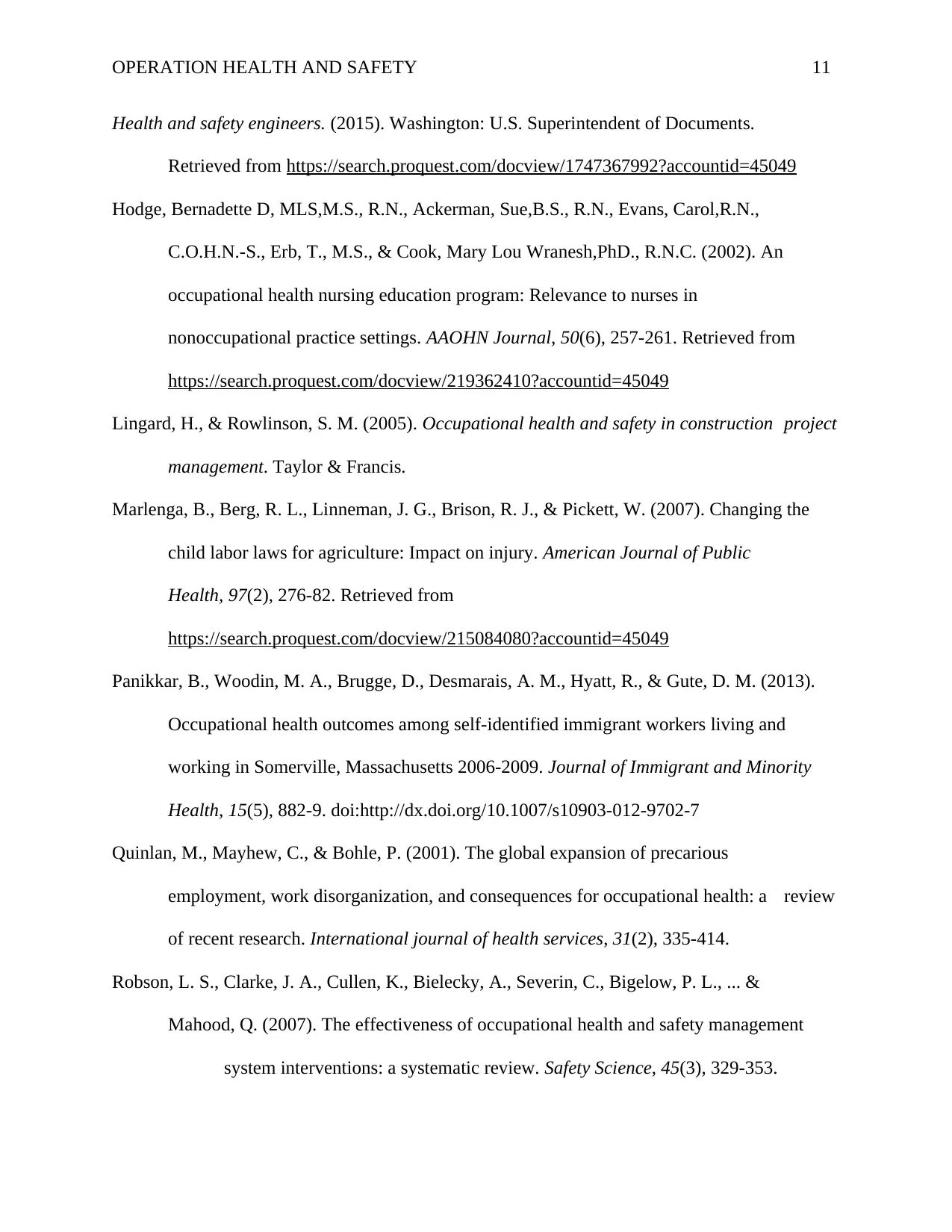
OPERATION HEALTH AND SAFETY 11
Health and safety engineers. (2015). Washington: U.S. Superintendent of Documents.
Retrieved from https://search.proquest.com/docview/1747367992?accountid=45049
Hodge, Bernadette D, MLS,M.S., R.N., Ackerman, Sue,B.S., R.N., Evans, Carol,R.N.,
C.O.H.N.-S., Erb, T., M.S., & Cook, Mary Lou Wranesh,PhD., R.N.C. (2002). An
occupational health nursing education program: Relevance to nurses in
nonoccupational practice settings. AAOHN Journal, 50(6), 257-261. Retrieved from
https://search.proquest.com/docview/219362410?accountid=45049
Lingard, H., & Rowlinson, S. M. (2005). Occupational health and safety in construction project
management. Taylor & Francis.
Marlenga, B., Berg, R. L., Linneman, J. G., Brison, R. J., & Pickett, W. (2007). Changing the
child labor laws for agriculture: Impact on injury. American Journal of Public
Health, 97(2), 276-82. Retrieved from
https://search.proquest.com/docview/215084080?accountid=45049
Panikkar, B., Woodin, M. A., Brugge, D., Desmarais, A. M., Hyatt, R., & Gute, D. M. (2013).
Occupational health outcomes among self-identified immigrant workers living and
working in Somerville, Massachusetts 2006-2009. Journal of Immigrant and Minority
Health, 15(5), 882-9. doi:http://dx.doi.org/10.1007/s10903-012-9702-7
Quinlan, M., Mayhew, C., & Bohle, P. (2001). The global expansion of precarious
employment, work disorganization, and consequences for occupational health: a review
of recent research. International journal of health services, 31(2), 335-414.
Robson, L. S., Clarke, J. A., Cullen, K., Bielecky, A., Severin, C., Bigelow, P. L., ... &
Mahood, Q. (2007). The effectiveness of occupational health and safety management
system interventions: a systematic review. Safety Science, 45(3), 329-353.
Health and safety engineers. (2015). Washington: U.S. Superintendent of Documents.
Retrieved from https://search.proquest.com/docview/1747367992?accountid=45049
Hodge, Bernadette D, MLS,M.S., R.N., Ackerman, Sue,B.S., R.N., Evans, Carol,R.N.,
C.O.H.N.-S., Erb, T., M.S., & Cook, Mary Lou Wranesh,PhD., R.N.C. (2002). An
occupational health nursing education program: Relevance to nurses in
nonoccupational practice settings. AAOHN Journal, 50(6), 257-261. Retrieved from
https://search.proquest.com/docview/219362410?accountid=45049
Lingard, H., & Rowlinson, S. M. (2005). Occupational health and safety in construction project
management. Taylor & Francis.
Marlenga, B., Berg, R. L., Linneman, J. G., Brison, R. J., & Pickett, W. (2007). Changing the
child labor laws for agriculture: Impact on injury. American Journal of Public
Health, 97(2), 276-82. Retrieved from
https://search.proquest.com/docview/215084080?accountid=45049
Panikkar, B., Woodin, M. A., Brugge, D., Desmarais, A. M., Hyatt, R., & Gute, D. M. (2013).
Occupational health outcomes among self-identified immigrant workers living and
working in Somerville, Massachusetts 2006-2009. Journal of Immigrant and Minority
Health, 15(5), 882-9. doi:http://dx.doi.org/10.1007/s10903-012-9702-7
Quinlan, M., Mayhew, C., & Bohle, P. (2001). The global expansion of precarious
employment, work disorganization, and consequences for occupational health: a review
of recent research. International journal of health services, 31(2), 335-414.
Robson, L. S., Clarke, J. A., Cullen, K., Bielecky, A., Severin, C., Bigelow, P. L., ... &
Mahood, Q. (2007). The effectiveness of occupational health and safety management
system interventions: a systematic review. Safety Science, 45(3), 329-353.
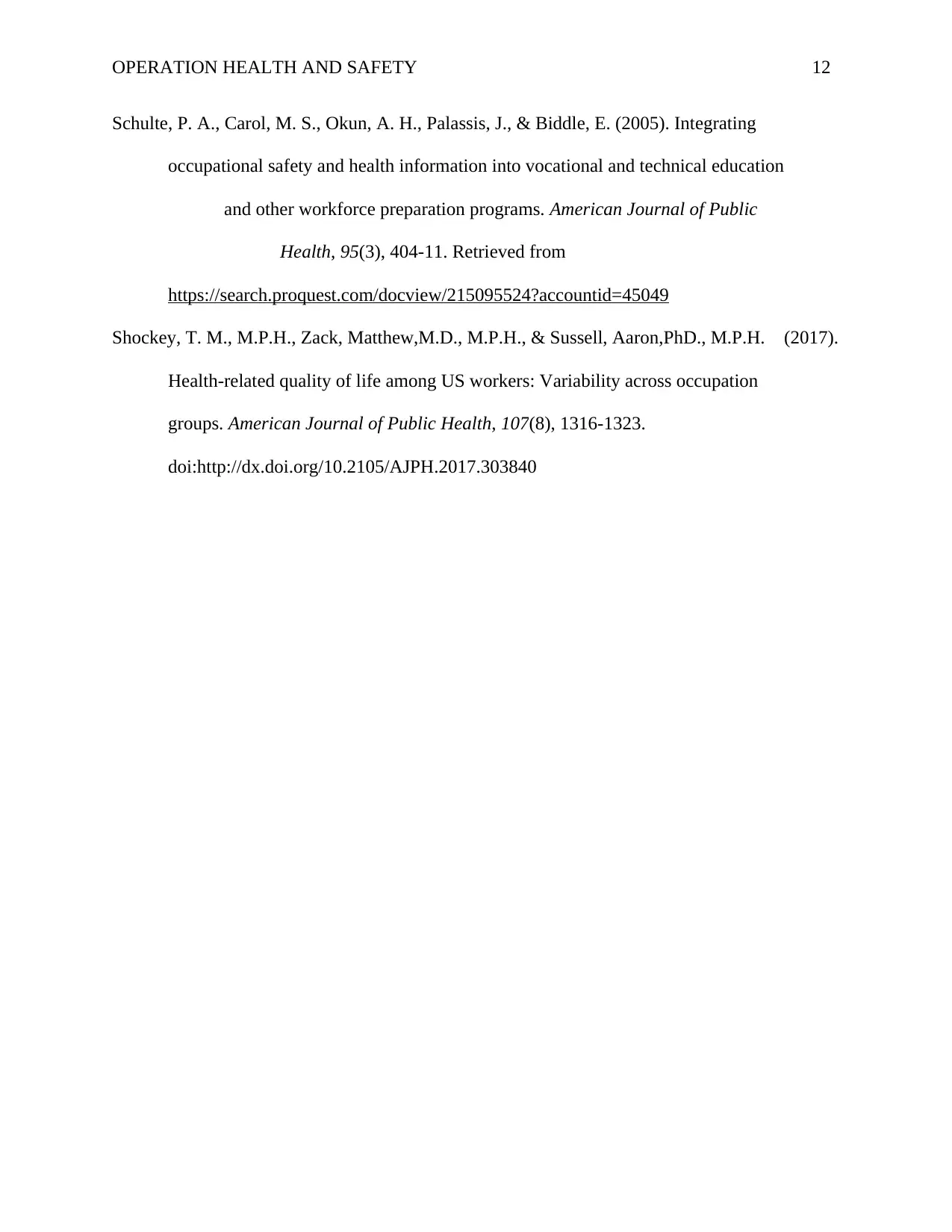
OPERATION HEALTH AND SAFETY 12
Schulte, P. A., Carol, M. S., Okun, A. H., Palassis, J., & Biddle, E. (2005). Integrating
occupational safety and health information into vocational and technical education
and other workforce preparation programs. American Journal of Public
Health, 95(3), 404-11. Retrieved from
https://search.proquest.com/docview/215095524?accountid=45049
Shockey, T. M., M.P.H., Zack, Matthew,M.D., M.P.H., & Sussell, Aaron,PhD., M.P.H. (2017).
Health-related quality of life among US workers: Variability across occupation
groups. American Journal of Public Health, 107(8), 1316-1323.
doi:http://dx.doi.org/10.2105/AJPH.2017.303840
Schulte, P. A., Carol, M. S., Okun, A. H., Palassis, J., & Biddle, E. (2005). Integrating
occupational safety and health information into vocational and technical education
and other workforce preparation programs. American Journal of Public
Health, 95(3), 404-11. Retrieved from
https://search.proquest.com/docview/215095524?accountid=45049
Shockey, T. M., M.P.H., Zack, Matthew,M.D., M.P.H., & Sussell, Aaron,PhD., M.P.H. (2017).
Health-related quality of life among US workers: Variability across occupation
groups. American Journal of Public Health, 107(8), 1316-1323.
doi:http://dx.doi.org/10.2105/AJPH.2017.303840
⊘ This is a preview!⊘
Do you want full access?
Subscribe today to unlock all pages.

Trusted by 1+ million students worldwide
1 out of 12
Related Documents
Your All-in-One AI-Powered Toolkit for Academic Success.
+13062052269
info@desklib.com
Available 24*7 on WhatsApp / Email
![[object Object]](/_next/static/media/star-bottom.7253800d.svg)
Unlock your academic potential
Copyright © 2020–2025 A2Z Services. All Rights Reserved. Developed and managed by ZUCOL.





